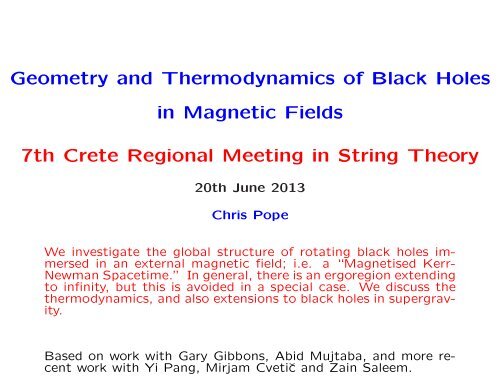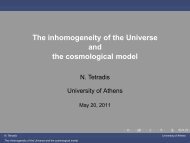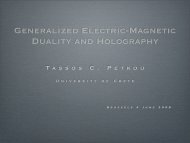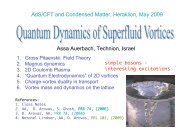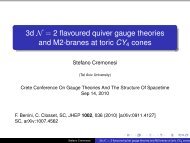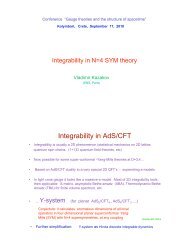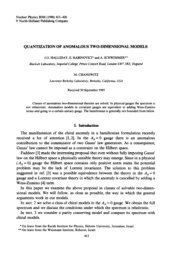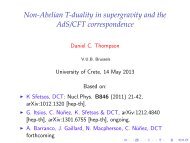Geometry and Thermodynamics of Black Holes in Magnetic Fields ...
Geometry and Thermodynamics of Black Holes in Magnetic Fields ...
Geometry and Thermodynamics of Black Holes in Magnetic Fields ...
You also want an ePaper? Increase the reach of your titles
YUMPU automatically turns print PDFs into web optimized ePapers that Google loves.
<strong>Geometry</strong> <strong>and</strong> <strong>Thermodynamics</strong> <strong>of</strong> <strong>Black</strong> <strong>Holes</strong><strong>in</strong> <strong>Magnetic</strong> <strong>Fields</strong>7th Crete Regional Meet<strong>in</strong>g <strong>in</strong> Str<strong>in</strong>g Theory20th June 2013Chris PopeWe <strong>in</strong>vestigate the global structure <strong>of</strong> rotat<strong>in</strong>g black holes immersed<strong>in</strong> an external magnetic field; i.e. a “Magnetised Kerr-Newman Spacetime.” In general, there is an ergoregion extend<strong>in</strong>gto <strong>in</strong>f<strong>in</strong>ity, but this is avoided <strong>in</strong> a special case. We discuss thethermodynamics, <strong>and</strong> also extensions to black holes <strong>in</strong> supergravity.Based on work with Gary Gibbons, Abid Mujtaba, <strong>and</strong> more recentwork with Yi Pang, Mirjam Cvetič <strong>and</strong> Za<strong>in</strong> Saleem.
Astrophysical <strong>Black</strong> Hole <strong>in</strong> an External <strong>Magnetic</strong> Field• <strong>Black</strong> holes are known to occur at the centre <strong>of</strong> most galaxies.These will <strong>in</strong> general have large angular momentum, ow<strong>in</strong>gto the accretion processes <strong>in</strong>volv<strong>in</strong>g <strong>in</strong>fall<strong>in</strong>g matter.• Bl<strong>and</strong>ford <strong>and</strong> Znajek proposed a mechanism <strong>in</strong> which themagnetic field generated by the circulation <strong>of</strong> charged particles<strong>in</strong> an equatorial accretion disc leads to electrostatic fieldsthat accelerate charged particles near the horizon, generat<strong>in</strong>gradiation that itself gives rise to electron-positron pair production.This <strong>in</strong> turn can lead to a net extraction <strong>of</strong> energyfrom the black hole via a Penrose-type process, thus possiblyprovid<strong>in</strong>g a powerful energy source at the galactic nucleus.• Wald considered a neutral rotat<strong>in</strong>g black hole (Kerr solution)<strong>in</strong> the background <strong>of</strong> an external magnetic field. As withBl<strong>and</strong>ford <strong>and</strong> Znajek, the magnetic field was treated as a“test field”; i.e. the back-reaction <strong>of</strong> the magnetic field onthe geometry was neglected.• Wald argued that if the black hole has mass m <strong>and</strong> angularmomentum j = am, then <strong>in</strong> the presence <strong>of</strong> an external magneticfield B it becomes energetically favourable for the blackhole to acquire an electric charge Q, given byQ = 2jB .This could occur via a vacuum breakdown through pair production.
Exact Solution with Back Reaction?• The notion <strong>of</strong> a black hole immersed <strong>in</strong> an “orig<strong>in</strong>ally uniformmagnetic field” is a little problematic <strong>in</strong> general relativity,s<strong>in</strong>ce the total electromagnetic energy will be <strong>in</strong>f<strong>in</strong>ite, <strong>and</strong>spacetime will necessarily become highly non-M<strong>in</strong>kowskian at<strong>in</strong>f<strong>in</strong>ity.• An exact solution that is perhaps the closest to this is provided,<strong>in</strong> the absence <strong>of</strong> rotation, by the Schwarzschild-Melv<strong>in</strong>metric, withds 2 = H [−fdt 2 + f −1 dr 2 + r 2 dθ 2 ] + r2 s<strong>in</strong> 2 θHf = 1 − 2m r , H = (1 + 1 4 B2 r 2 s<strong>in</strong> 2 θ) 2 ,A = Br2 s<strong>in</strong> 2 θ√Hdφ .dφ 2 ,• This is asymptotic to the Melv<strong>in</strong> universe at large r. (i.e.when r >> m). It approaches the M<strong>in</strong>kowski metric nearthe axis (θ = 0 or θ = π), but is highly non-M<strong>in</strong>kowskianaway from the axis. This is most clearly seen <strong>in</strong> cyl<strong>in</strong>dricalcoord<strong>in</strong>atesρ = r s<strong>in</strong> θ , z = r cos θ .
The Melv<strong>in</strong> Universe• In cyl<strong>in</strong>drical coord<strong>in</strong>ates, Melv<strong>in</strong> solution (m = 0) isds 2 = H (−dt 2 + dz 2 + dρ 2 ) + H −1 ρ 2 dφ 2 ,F = dA = B H −1 ρdρ ∧ dφ , H = (1 + 1 4 B2 ρ 2 ) 2 .• If B 2 ρ 2
Rotat<strong>in</strong>g Generalisations?• Rotat<strong>in</strong>g generalisations have been obta<strong>in</strong>ed before. The solutionsare too complicated to work with reliably by h<strong>and</strong>,so it is useful first to reconstruct from scratch, us<strong>in</strong>g algebraiccomput<strong>in</strong>g. We used a solution-generat<strong>in</strong>g techniqueto “magnetise” Kerr-Newman, via a Kaluza-Kle<strong>in</strong> reductionto three dimensions. The start<strong>in</strong>g po<strong>in</strong>t is E<strong>in</strong>ste<strong>in</strong>-Maxwelltheory <strong>in</strong> four dimensions:L 4 = R − F 2 .We then assume a metric with a spacelike Kill<strong>in</strong>g vector ∂/∂φ<strong>and</strong> reduce to three dimensions:ds 2 4 = e2ϕ d¯s 2 3 + e−2ϕ (dφ + 2Ā) 2 ,A = Ā + χ (dφ + 2Ā) .This gives the three-dimensional Lagrangian¯L 3 = ¯R − 2(∂ϕ) 2 − 2e ϕ (∂χ) 2 − e −4ϕ ¯F 2 − e −2ϕ ¯F 2 ,where ¯F = dĀ <strong>and</strong> ¯F = dĀ + 2χ dĀ.• Dualis<strong>in</strong>g Ā <strong>and</strong> Ā; e −2ϕ ¯∗ ¯F = dψ <strong>and</strong> e −4ϕ ¯∗ ¯F = dσ − 2χ dψgives 3D gravity coupled to a nonl<strong>in</strong>ear sigma model:L 3 = ¯R − 2(∂ϕ) 2 − 2e ϕ [(∂χ) 2 + (∂ψ) 2 ] − 2e 2ϕ (∂σ − 2χ∂ψ) 2 .
SU(2, 1) Transformations, <strong>and</strong> Magnetisation• The scalar sigma model metricdΣ 2 = dϕ 2 + e 2ϕ [dχ 2 + dψ 2 ] + e 4ϕ (dσ − 2χdψ) 2˜is CP 2 = SU(2, 1)/U(2), the non-compact (negative curvature)version <strong>of</strong> CP 2 . Def<strong>in</strong><strong>in</strong>g matrices E b a with just a 1 atrow a, column b, <strong>and</strong> H = E 0 0 − E 2 2 , we can parameterise acoset representative, <strong>and</strong> SU(2, 1) element, asV = e ϕH e −2i σE 0 2 e√2χ(E0 1 +E 2) 1 e −i √ 2ψ(E 1 0 −E 2) 1 .We haveV † ηV = η , η =⎛⎜⎝0 0 −10 1 0−1 0 0⎞⎟⎠ ,with η be<strong>in</strong>g the <strong>in</strong>variant metric <strong>of</strong> SU(2, 1). The Lagrangiancan be written as L 3 = R − tr(M −1 ∂M) 2 where M = V † V.L 3 is manifestly <strong>in</strong>variant under M −→ M ′ = U † MU where Uis any constant SU(2, 1) matrix, obey<strong>in</strong>g U † ηU = η.
Magnetisation <strong>of</strong> Kerr-Newman <strong>Black</strong> Hole• We start from the rotat<strong>in</strong>g, charged Kerr-Newman black hole:ds 2 4 = ( −fdt2 + R 2 dr2 )∆ + dθ2A = Φ 0 dt + Φ 3 (dφ − ωdt) ,where+ Σ s<strong>in</strong>2 θR 2 (dφ − ωdt) 2 ,R 2 = r 2 + a 2 cos 2 θ , ∆ = (r 2 + a 2 ) − 2mr + q 2 ,ω = a(2mr − q2 ), Σ = (r 2 + a 2 ) 2 − a 2 ∆ s<strong>in</strong> 2 θ ,Σf = R2 ∆Σ , Φ 0 = qr(r2 + a 2 ), Φ 3 = − aqr s<strong>in</strong>2 θΣR 2 .• We now reduce to three dimensions on ∂/∂φ, apply the magnetis<strong>in</strong>gtransformation, which turns out to beU =⎛⎜⎝1 0 0B√21 0B 24⎞⎟⎠ ,B√ 1 2<strong>and</strong> then retrace the steps back to four dimensions.
Further SU(2, 1) Transformations• Amongst the other possible transformations with<strong>in</strong> the SU(2, 1)symmetry group are electrifications (add<strong>in</strong>g an external electricfield):U =⎛(B+i E)⎜⎝(B 2 +E 2 )41 0 0⎟⎠ .(B−i√E)1 2√21 0• Electric/magnetic duality transformations, which <strong>in</strong> four dimensionstake the formF −→ F ′ = F cos α + ∗F s<strong>in</strong> α ,This is implemented <strong>in</strong> 3 dimensions by the SU(2, 1) matrix⎛e − i ⎞3 α 0 0U =⎜ 0 e 2i3 α 0.⎝0 0 e − 3 i ⎟α ⎠⎞
Magnetisation <strong>of</strong> Kerr-Newman <strong>Black</strong> Hole• Applied to Schwarzschild, it <strong>in</strong>deed gives Schwarzschild-Melv<strong>in</strong>.• Applied to the Kerr-Newman metric (with electric <strong>and</strong> magneticcharges q <strong>and</strong> p, it gives a rather <strong>in</strong>digestible result:wherewithds 2 4 =[ ( drH − fdt 2 + R 2 2 )]∆ + dθ2A = Φ 0 dt + Φ 3 (dφ − ωdt) ,H = 1 + H (1)B + H (2) B 2 + H (3) B 3 + H (4) B 4R 2H (1) = 2aqr s<strong>in</strong> 2 θ − 2p(r 2 + a 2 ) cos θ ,H (2) = 1 2 [(r2 + a 2 ) 2 − a 2 ∆ s<strong>in</strong> 2 θ] s<strong>in</strong> 2 θ + 2˜q2 3 (a 2 + r 2 cos 2 θ) ,+ Σ s<strong>in</strong>2 θH R 2 (dφ − ωdt) 2 ,H (3) = −pa 2 ∆ s<strong>in</strong> 2 θ cos θ − qa∆r [r2 (3 − cos 2 θ) cos 2 θ + a 2 (1 + cos 2 θ)] + aq(r2 + a 2 ) 2 (1 + cos 2 θ)2r− 1 2 p(r4 − a 4 ) s<strong>in</strong> 2 θ cos θ + q˜q2 a[(2r 2 + a 2 ) cos 2 θ + a 2 ]− 12r2 p˜q2 (r 2 + a 2 ) cos 3 θ ,H (4) = 1 16 (r2 + a 2 ) 2 R 2 s<strong>in</strong> 4 θ + 1 4 ma2 r(r 2 + a 2 ) s<strong>in</strong> 6 θ + 1 4 ma2˜q 2 r(cos 2 θ − 5) s<strong>in</strong> 2 θ cos 2 θ+ 1 4 m2 a 2 [r 2 (cos 2 θ − 3) 2 cos 2 θ + a 2 (1 + cos 2 θ) 2 ]+ 1 8˜q2 (r 2 + a 2 )(r 2 + a 2 + a 2 cos 2 θ) s<strong>in</strong> 2 θ cos 2 θ + 116˜q4 [r 2 cos 2 θ + a 2 (1 + s<strong>in</strong> 2 θ) 2 ] cos 2 θ<strong>and</strong> we have def<strong>in</strong>ed ˜q 2 ≡ q 2 + p 2 .The function ω is given by
whereω = (2mr − ˜q2 )a + ω (1) B + ω (2) B 2 + ω (3) B 3 + ω (4) B 4,Σω (1) = −2qr(r 2 + a 2 ) + 2ap∆ cos θ ,ω (2) = − 3 2 a˜q2 (r 2 + a 2 + ∆ cos 2 θ) ,ω (3) = 4qm 2 a 2 r + 1 2 ap˜q4 cos 3 θ − 1 2 qr(r2 + a 2 )[r 2 − a 2 + (r 2 + 3a 2 ) cos 2 θ]+ 1 2 ap(r2 + a 2 )[3r 2 + a 2 − (r 2 − a 2 ) cos 2 θ] cos θ + 1 2 q˜q2 r[(r 2 + 3a 2 ) cos 2 θ − 2a 2 ]+ 1 2 ap˜q2 [3r 2 + a 2 + 2a 2 cos 2 θ] cos θ − am˜q 2 (2aq + pr cos 3 θ)+qm[r 4 − a 4 + r 2 (r 2 + 3a 2 ) s<strong>in</strong> 2 θ] − apmr[2R 2 + (r 2 + a 2 ) s<strong>in</strong> 2 θ] ,ω (4) = 1 2 a3 m 3 r(3 + cos 4 θ) − 1 16 a˜q6 cos 4 θ − 1 8 a˜q4 [r 2 (2 + s<strong>in</strong> 2 θ) cos 2 θ + a 2 (1 + cos 2 θ)]+ 116 a˜q2 (r 2 + a 2 )[r 2 (1 − 6 cos 2 θ + 3 cos 4 θ) − a 2 (1 + cos 4 θ)] − 1 4 a3 m 2˜q 2 (3 + cos 4 θ)+ 1 4 am2 [r 4 (3 − 6 cos 2 θ + cos 4 θ) + 2a 2 r 2 (3 s<strong>in</strong> 2 θ − 2 cos 4 θ) − a 4 (1 + cos 4 θ)]+ 1 8 am˜q4 r cos 4 θ + 1 4 am˜q2 r[2r 2 (3 − cos 2 θ) cos 2 θ − a 2 (1 − 3 cos 2 θ − 2 cos 4 θ)]+ 1 8 amr(r2 + a 2 )[r 2 (3 + 6 cos 2 θ − cos 4 θ) − a 2 (1 − 6 cos 2 θ − 3 cos 4 θ)] .• This solution is <strong>of</strong>ten assumed to be asymptotic to the Melv<strong>in</strong>universe. In general, it isn’t. Look at g tt :• At large r, for generic θ, the metric component g tt does behavejust like <strong>in</strong> Melv<strong>in</strong>, withg tt −→ − 116 B4 r 4 s<strong>in</strong> 4 θ .But, near to the z axis at large distance, g tt goes (arbitrarily)positive, signal<strong>in</strong>g an ergoregion extend<strong>in</strong>g out to <strong>in</strong>f<strong>in</strong>ity.
• This is evident <strong>in</strong> the cyl<strong>in</strong>drical coord<strong>in</strong>ates ρ = r s<strong>in</strong> θ <strong>and</strong>z = r cos θ where, for fixed ρ, a large z expansion givesg tt −→ 16B6 (q + amB) 2 ρ 2W (ρ) 2 z 2− 4B6 (q + amB)[8qm + aB(q 2 + 4m 2 )]ρ 2W (ρ) 2 z + O(z 0 ) ,So not asymptotically Melv<strong>in</strong> near the axis, <strong>and</strong> an <strong>in</strong>f<strong>in</strong>iteergoregion.• The energy <strong>of</strong> a particle with 4-momentum p µ , measured withrespect to a future-directed timelike Kill<strong>in</strong>g vector K, isE = −K µ p µHere, we are th<strong>in</strong>k<strong>in</strong>g <strong>of</strong> K = ∂/∂t. If K becomes spacelike,i.e. if there is an ergoregion, then the energy can becomenegative. Can then extract energy by the Penrose Process,<strong>in</strong> which a particle decays <strong>in</strong>to two, one with negative energythat falls <strong>in</strong>to the black hole, <strong>and</strong> the other, with more energythan the orig<strong>in</strong>al particle, that escapes.• In the orig<strong>in</strong>al Kerr-Newman black hole there is a uniquechoice <strong>of</strong> asymptotically-timelike Kill<strong>in</strong>g vector (i.e. K =∂/∂t). In the magnetised solution we f<strong>in</strong>d that providedwe take q = −amB, there is a family <strong>of</strong> possible choicesK = ∂/∂t + Ω ∂/∂φ, if the angular velocity Ω lies <strong>in</strong> an appropriaterange.
q = −amB Magnetised Kerr-Newman• With q = −amB, the problem <strong>of</strong> an ergoregion at <strong>in</strong>f<strong>in</strong>ity canbe avoided. Us<strong>in</strong>g the coord<strong>in</strong>ate ˜φ = φ − Ω t, first look atthe <strong>of</strong>f-diagonal metric component g t˜φat large z:g t˜φ = 2(8Ω + 12am2 B 4 + a 3 m 2 B 6 )ρ 2(4 + a 2 m 2 B 4 + B 2 ρ 2 ) 2 + O( 1 z ) .Choos<strong>in</strong>g Ω = Ω s , wherewe f<strong>in</strong>d at large z thatΩ s = − 1 8 am2 B 4 (12 + a 2 B 2 ) ,g t˜φ = −8amB2 (4 + a 2 m 2 B 4 )ρ 2(4 + a 2 m 2 B 4 + B 2 ρ 2 ) 2 1z + O( 1 z 2) ,g tt = − 116 (4 + a2 m 2 B 4 + B 2 ρ 2 ) 2 + O( 1 z ) ,<strong>and</strong> so the metric near the axis is then genu<strong>in</strong>ely asymptoticto the static Melv<strong>in</strong> universe.
Asymptotically-Melv<strong>in</strong> Magnetised Kerr-Newman• In the asymptotically static Melv<strong>in</strong> frame with timelike Kill<strong>in</strong>gvector K = ∂/∂t + Ω s ∂/∂φ, the q = −amB magnetised Kerr-Newman-Melv<strong>in</strong> solution will still have an ergoregion <strong>in</strong> theform <strong>of</strong> an oblate spheroid outside the outer horizon (verylike <strong>in</strong> the Kerr solution):• In the Kerr solution, ∂/∂t is the unique Kill<strong>in</strong>g vector thatis timelike at <strong>in</strong>f<strong>in</strong>ity, <strong>and</strong> hence it is the unique choice asgenerator <strong>of</strong> time translations:• In the magnetised Kerr-Newman solution there is <strong>in</strong> fact arange <strong>of</strong> angular velocities Ω around Ω = Ω s for which theergoregion is <strong>of</strong> only f<strong>in</strong>ite extent, <strong>and</strong> conf<strong>in</strong>ed to the vic<strong>in</strong>ity<strong>of</strong> the black hole.
Conserved Charge <strong>and</strong> Angular Momentum• These can be calculated most simply <strong>in</strong> the KK reduced 3Dlanguage. The physical charge is given by the Gaussian <strong>in</strong>tegral∫∫Q = 1∆φ∗F =4π S2 4π S 2 e−4ϕ ¯∗ ¯F ,= ∆φ ∫dψ = ∆φ [ ] θ=πψ = q(1 − 14π 4π4 q2 B 2 ) + 2amB .θ=0∆φ is the period <strong>of</strong> the azimuthal coord<strong>in</strong>ate φ, determ<strong>in</strong>edby requir<strong>in</strong>g no conical s<strong>in</strong>gularities at N <strong>and</strong> S poles <strong>of</strong> S 2 :]∆φ = 2π[1 + 3 2 q2 B 2 + 2aqmB 3 + (a 2 m 2 +16 1 q4 )B 4 .• For angular momentum, follow<strong>in</strong>g Wald, for every Kill<strong>in</strong>g vectorξ the Noether method gives a conserved chargeQ[ξ] = 116π∫S 2 ∗P , P = dξ + 4(ξµ A µ ) F .Tak<strong>in</strong>g the azimuthal Kill<strong>in</strong>g vector with ξ = ∂/∂ ˜φ, where˜φ = (2π/∆φ) φ has canonical 2π period, then as a 1-form,<strong>and</strong> <strong>in</strong> the 3D language, we have
ξ = ∆φ2π e−2ϕ (dφ + 2Ā) <strong>and</strong> henceP = ∆φ [e −2ϕ ¯F + 2χ ¯F − (e −2ϕ dϕ − 2χdχ) ∧ (dφ + 2Ā)πThis gives∗P = ∆φ []dσ ∧ (dφ + 2Ā) − ¯∗(dϕ − 2e 2ϕ χdχ) ,π<strong>and</strong> so the angular momentum isJ = 116π∫S 2 ∗P = ( ∆φ4π) 2 ∫dσ =( ∆φ4π) 2 [ ] θ=πσθ=0= am + 1 2 q3 B + 9 2 amq2 B 2 + 1 2 qB3 (12a 2 m 2 − q 4 )+ 1 16 amB4 (48a 2 m 2 − 11q 4 ) .(Note: This <strong>in</strong>cludes the electromagnetic field contributionas well as the purely gravitational “Komar” contribution from∗dξ. Each by itself is s<strong>in</strong>gular <strong>in</strong> the Melv<strong>in</strong> background, butthe sum is non-s<strong>in</strong>gular.)].
<strong>Thermodynamics</strong>• We can expect that the first law should take the formdE = T dS + ΩdJ + ΦdQ − µdB ,We have calculated the conserved charges Q <strong>and</strong> J, <strong>and</strong> thecalculation <strong>of</strong> the entropy S <strong>and</strong> temperature T is straightforward.Unusual asymptotics <strong>of</strong> the Melv<strong>in</strong> background meanthat calculat<strong>in</strong>g the mass E, the angular velocity Ω the electrostaticpotential Φ, <strong>and</strong> the magnetic moment µ is trickier.• The mass is given by (??) E = (∆φ/2π) m. We can seeksolution <strong>of</strong> the first law for Ω, Φ <strong>and</strong> µ. This works, <strong>and</strong> isnon-trivial s<strong>in</strong>ce we have 4 equations for 3 unknowns.• Solution is complicated. At lead<strong>in</strong>g order, we haveµ = aq(1 + a 2 m 2 B 4 ) + O(q 2 ) ,Ω =ar+ 2 + − 2qBr +a2 r+ 2 + + a2 O(B2 ) ,Φ = qr +r 2 + + a2 −3aq2 B2(r 2 + + a2 ) + O(B2 ) .<strong>Magnetic</strong> moment µ ∼ aq ∼ JQ/M, so at lead<strong>in</strong>g order werecover the well-known black hole gyromagnetic ratio g ∼ 2.• Satisfies Smarr-type relation E = 2T S + 2ΩJ + ΦQ + µB.
Magnetised <strong>Black</strong> <strong>Holes</strong> <strong>in</strong> STU Supergravity• We can magnetise black holes <strong>in</strong> supergravities too. Currentlywe (Cvetič, Gibbons, Saleem, CNP) are look<strong>in</strong>g <strong>in</strong> the fourdimensionalSTU model (N = 2 supergravity coupled to 3vector multiplets). Now have four <strong>in</strong>dependent U(1) gaugefields, so four charges <strong>and</strong> four magnetic fields. We no use theO(4, 4) symmetry <strong>of</strong> the associated KK reduced 3-dimensionalsigma model to generate the magnetised solutions.• As well as magnetis<strong>in</strong>g electric black holes, it is also now<strong>of</strong> <strong>in</strong>terest to magnetise magnetically-charged black holes.Consider static black holes for simplicity. The metric isds 2 = H ds 2 3 + H−1 s<strong>in</strong> 2 θ (dφ − ωdt) 2 ,(ds 2 3 = −r(2 − 2m)dt2 + R 1 r 2 r 3 r 4 dθ 2 + R )1r 2 r 3 r 4r(r − 2m) dr2ω =4∑i=1[− p iB i+ p iB 1 B 2 B 3 B 4 [r i + (r − 2m) cos 2 ]θ]r,2r i 8B i r iH 2 1 ∏ 4 (=(1 + 1r 1 r 2 r 3 r2 B ip i cos θ) 2 + B2 i r 1r 2 r 3 r 44 i=1ri2r i = r + 2m s<strong>in</strong>h 2 δ i , p i = 2m s<strong>in</strong>h δ i cosh δ i .,]s<strong>in</strong> 2 θ ,
Conical S<strong>in</strong>gularities <strong>and</strong> Force Balanc<strong>in</strong>g• To avoid conical s<strong>in</strong>gularity at the North (South) pole, φshould be identified with different periods at each:N pole :S pole :∆φ = 2π ∏ i∆φ = 2π ∏ i(1 + 1 2 B ip i ) ,(1 − 1 2 B ip i ) .In general, there is no s<strong>in</strong>gle choice <strong>of</strong> period ∆φ that elim<strong>in</strong>atesboth conical s<strong>in</strong>gularities. This reflects the fact thatthere is a net force on the black hole, <strong>and</strong> it must thereforebe supported by a “strut,” which is described by an energymomentumtensor with a delta-function s<strong>in</strong>gularity on theaxis. This happens, for example, for a magnetic Reissner-Nordström black hole <strong>in</strong> an external magnetic field. (Or theS-dual, an electric black hole <strong>in</strong> an external electric field.)• With four separate gauge fields <strong>in</strong> the STU model we cantune the fields <strong>and</strong> the charges to achieve a force balance:∏(1 + 1 2 B ip i ) = ∏ (1 − 1 2 B ip i ) .iiThis provides families <strong>of</strong> non-s<strong>in</strong>gular magnetic black holes<strong>in</strong> external magnetic fields. These provide <strong>in</strong>terest<strong>in</strong>g modelsfor <strong>in</strong>vestigat<strong>in</strong>g thermodynamics <strong>of</strong> systems <strong>in</strong> externalbackgrounds.
Conclusions <strong>and</strong> Open Problems• A rotat<strong>in</strong>g generalisation <strong>of</strong> the asymptotically-Melv<strong>in</strong> magnetisedSchwarzschild solution does exist, but it must carry avery specific electric charge, related to its mass <strong>and</strong> angularmomentum <strong>and</strong> the external B field. Otherwise, it has anergoregion extend<strong>in</strong>g to <strong>in</strong>f<strong>in</strong>ity close to the axis.• The thermodynamics is quite subtle, ow<strong>in</strong>g to the unusualasymptotic behaviour <strong>of</strong> the Melv<strong>in</strong> type background. Charge<strong>and</strong> angular momentum can be calculated from conservedcurrents, but ab <strong>in</strong>itio computation <strong>of</strong> angular velocity, electricpotential <strong>and</strong> magnetic moment is more difficult. Framedragg<strong>in</strong>g<strong>of</strong> the magnetic field is rather complex.• More extensive analysis <strong>of</strong> the global structure is needed.Also, a detailed <strong>in</strong>vestigation <strong>of</strong> “asymptotically Melv<strong>in</strong>” boundaryconditions for fields.• Melv<strong>in</strong>/CFT type dualities?• Magnetisation <strong>of</strong> black holes <strong>in</strong> supergravities opens up newpossibilities; non-s<strong>in</strong>gular magnetised magnetic black holes,etc.• Recent work (Cvetič, Guica, Saleem) has shown how relatedsolution-generat<strong>in</strong>g transformations can be used to <strong>in</strong>terpolatebetween black hole backgrounds <strong>and</strong> “subtracted geometries”that can be used for study<strong>in</strong>g the microscopic entropy.We are <strong>in</strong>vestigat<strong>in</strong>g these further.


